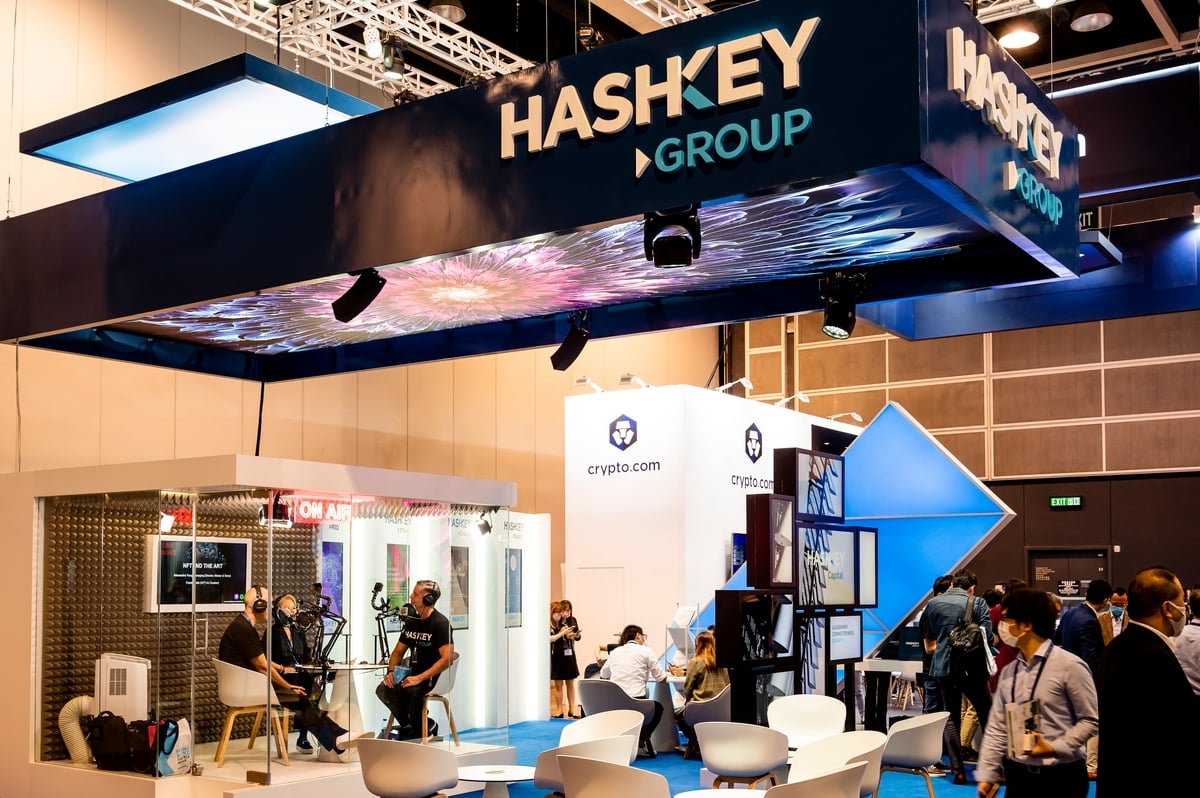
Is bitcoin really digital gold? In 2025, the leading crypto has failed to answer that question CNBC
source

HashKey Holdings Ltd., a leading cryptocurrency exchange operator, is preparing to open investor orders next week for its highly anticipated Hong Kong IPO. The company aims to raise at least $200 million and plans to list before the end of December. This move comes as Hong Kong pushes to become a major digital asset hub in Asia, following regulatory efforts to attract crypto firms and revive investor interest.
Cryptocurrency exchange operator HashKey Holdings Ltd. is preparing to open investor orders for its Hong Kong IPO as early as next week. According to sources familiar with the matter, the company is targeting to raise at least $200 million in the offering.
The IPO could see the firm listed on the Hong Kong Stock Exchange before the end of December. Final details about the deal size and listing date may still change. HashKey has not responded to media requests for official comment.
This public listing arrives during a push by Hong Kong to establish itself as a hub for digital assets in Asia. The offering could provide a boost to local capital markets and attract more crypto firms to the region.
Founded in 2018 by Xiao Feng, HashKey was spun off from Wanxiang Group, a Chinese conglomerate involved in automotive and energy sectors. Since its founding, HashKey has developed into a multi-jurisdiction crypto business.
The company provides services such as cryptocurrency trading, venture investments, and digital asset management. It operates in Hong Kong, Singapore, Japan, the United Arab Emirates, Ireland, and Bermuda.
HashKey is also known for being an early corporate investor in Ethereum. The firm received a $30 million investment from Gaorong Ventures at a pre-money valuation of over $1 billion, according to people familiar with the deal.
According to its IPO documents, HashKey reported a loss of HK$506 million (around $65 million) in the first half of 2025. This loss is narrower compared to the same period last year. Revenue during the period fell 26% to HK$384 million.
Despite the loss, the company reported HK$1.3 trillion (approximately $167 billion) in total spot trading volume as of September. This trading activity indicates strong user participation and demand on the platform.
HashKey’s business strategy includes long-term plans to expand its offerings and increase efficiency across its trading and asset management units.
The IPO aligns with Hong Kong’s broader strategy to revive its status as a regional crypto center. Since China banned crypto trading in 2021, Hong Kong has moved to create its own clear regulatory system for virtual assets.
In 2023, local authorities introduced a framework designed to license and monitor digital asset firms. The region is also considering additional policy changes to make it easier for local and foreign investors to participate in the crypto economy.
Although crypto activity in Hong Kong remains moderate, the listing of a firm like HashKey could attract attention from investors in China and other Asian markets. Authorities hope such listings can increase investor confidence and participation in the city’s regulated crypto environment.
A selloff in Bitcoin earlier this year affected market sentiment, but recent signs suggest recovery. Analysts attribute this to expectations that the U.S. Federal Reserve may lower interest rates soon.
Discover top-performing stocks in AI, Crypto, and Technology with expert analysis.
Kelvin Munene is a crypto and finance journalist with over 5 years of experience in market analysis and expert commentary. He holds a Bachelor’s degree in Journalism and Actuarial Science from Mount Kenya University and is known for meticulous research in cryptocurrency, blockchain, and financial markets. His work has been featured in top publications including Coingape, Cryptobasic, MetaNews, Coinedition, and Analytics Insight. Kelvin specializes in uncovering emerging crypto trends and delivering data-driven analyses to help readers make informed decisions. Outside of work, he enjoys chess, traveling, and exploring new adventures.
TLDR HashKey aims to raise $200M in a Hong Kong IPO, with listing expected this…


This stablecoin issuer has very different motivations for buying Bitcoin than most investors.
During the past three months, Bitcoin's (BTC 2.37%) price slid as much as 21%, sending the crypto market into a tizzy of anxiety. Right in the middle of that slump, the coin had an unusually committed buyer. Tether, the issuer of the USDT (USDT +0.01%) stablecoin, the world's largest, spent about $1 billion from its reserves into new Bitcoin purchases, expanding its already large stash of coins right when many investors were bailing out.
If a systemically important stablecoin issuer is buying the dip here, does that mean regular investors should, too?
Image source: Getty Images.
Before considering whether to imitate Tether, it helps to understand what game it's trying to play.
USDT is a dollar-pegged stablecoin that is backed by a large portfolio of reserves. Those reserves currently total about $181 billion, mostly in short-term U.S. Treasuries, with the rest in gold, Bitcoin, secured loans, and other investments. As of the end of the third quarter, management reported about $135 billion in Treasury holdings, $13 billion in gold, and $10 billion in Bitcoin inside that reserve portfolio. Those numbers put Tether among the largest non-government holders of both gold bullion, which it has also been accumulating at a rapid pace recently, and Bitcoin.
The recent $1 billion purchase of Bitcoin is thus part of a pattern of shoring up reserves when prices look favorable. What's more, Tether is profitable because it earns interest fees on its enormous Treasury bill and bond pile. So the company is using a slice of those profits to buy assets like Bitcoin and gold, which might boost its long-term returns and differentiate USDT from rival stablecoins that stick almost entirely to cash and bills for reserves.
So, should a regular investor buy Bitcoin because Tether is buying it? Probably not.
Tether can afford to funnel a slice of its substantial earnings into volatile assets like Bitcoin and easily wait out bad years if they occur. A household investor living off a salary or retirement income does not always have that luxury.
The core reason Tether likes having Bitcoin on its balance sheet overlaps with the basic investment thesis for owning some Bitcoin in a retirement portfolio. The coin can't have more of its supply printed like a fiat currency can, and thanks to its halving program, its scarcity increases over time as the rate of new supply being mined drops mechanically. Meanwhile, it is increasingly integrated into the traditional financial system, from large corporate treasuries to exchange-traded funds (ETFs) and even in some proposed sovereign reserves. So buying this asset right now is a bet that its adoption and scarcity will keep increasing during the next decade despite plenty of volatility along the way.
That points to a very different playbook from Tether's for those who choose to dabble. Spread your purchases out over time using dollar-cost averaging rather than doing one huge buy, mentally commit to holding your position for many years, and steel yourself for large declines without panic selling.
Tether's decision to buy the dip here is a vote of confidence in Bitcoin's long-term value, and it lines up with the idea that it's a sensible practice for most investors to own at least a small amount of it. The right way to follow suit is to keep your investment fairly modest, be consistent with slow accumulation of the coin, and to have a clear understanding that this is one of the riskier slices of a diversified portfolio.
Alex Carchidi has positions in Bitcoin. The Motley Fool has positions in and recommends Bitcoin. The Motley Fool has a disclosure policy.
*Average returns of all recommendations since inception. Cost basis and return based on previous market day close.
Invest better with The Motley Fool. Get stock recommendations, portfolio guidance, and more from The Motley Fool's premium services.
Making the world smarter, happier, and richer.
© 1995 – 2025 The Motley Fool. All rights reserved.
Market data powered by Xignite and Polygon.io.
About The Motley Fool
Our Services
Around the Globe
Free Tools
Affiliates & Friends

Bitcoin’s more than 30% drop from its record high underscores the volatility that has come to characterize the cryptocurrency.
Moves from previous cycles not only show how the current price swings are all part of bitcoin’s normal operating pattern but also how they may often precede a rally, according to figures compiled by CoinDesk Data for CNBC.
Bitcoin, the world’s largest cryptocurrency, dropped to a low of around $80,000 late last month before staging a rally and falling again this week. When bitcoin dropped to under $81,000, that represented an approximately 36% fall from its all-time high of around $126,000 hit earlier in October. As of Thursday, bitcoin was trading at over $93,000, according to Coinmetrics, a roughly 26% decline from its record high.
These price swings may seem large but they are normal in relation to bitcoin’s history.
Bitcoin’s price movement is often referred to in “cycles.” Generally, the bitcoin cycle refers to a four-year pattern of price movement that revolves around a key event known as the halving, a change to mining rewards that is written in bitcoin’s code. While there are signs that the typical timing and patterns of the cycles could be changing, the range of price movements appears to be consistent.
In the current cycle, bitcoin has already weathered a 32.7% pullback from March to August 2024 and a 31.7% decline between January and April 2025, according to CoinDesk Data.
“Looking at previous cycles, volatility of this magnitude appears consistent with long-term trends,” Jacob Joseph, senior research analyst at CoinDesk Data, told CNBC.
During the 2017 cycle, there were drawdowns of around 40% twice that year and then a 29% decline in November before bitcoin reached a new record high in December.
Looking back at the 2021 cycle, bitcoin recorded declines of 31.2% in January that year and 26% in February. There was a more than 55% correction between April and June 2021 as China banned bitcoin mining. The asset then rallied to a new high in November that year.
“While deeper mid-cycle corrections have certainly occurred, nearly all of them — aside from the mining-ban-drop in 2021 — took place within a broader bullish structure, often holding above key technical levels such as its 50-week moving average,” Joseph said.
Beginning Oct. 10, more than 1.6 million traders suffered a combined $19.37 billion erasure of leveraged positions over a 24-hour period. Many traders were forced out of their positions and the impact of that cascaded across the industry.
That effect is still being felt, according to Lucy Gazmararian, founder of Token Bay Capital.
″[It was the] biggest liquidation event in crypto’s history and that takes quite a few weeks to see the fallout from that and for the market to consolidate,” Gazmararian told “Access Middle East” on Thursday.
“It also coincided at a time when there’s a lot of concern that we are reaching the end of a bull market … so that has increased the levels of fear out there in the market.”
In the past, when the bull market ends and there is a period of depressed prices, often dubbed a “crypto winter,” bitcoin has tended to sit 70% to 80% below its all-time high. This has not yet happened. But concern about this coming to pass is weighing on investors’ minds.
“Really the timing of the drop, where we are in the cycle, that’s making investors cautious in case we do see that 80% drop,” Gazmararian said.
Get the best of CNBC Africa sent straight to your inbox with breaking business news, insights and updates from experts across the continent.
Loading security verification…
Get this delivered to your inbox, and more info about our products and services. By signing up for newsletters, you are agreeing to our Terms of Use and Privacy Policy.

Written & Edited by
Oihyun Kim
Bitcoin mining profitability plunged to record lows in late 2025 as the hash rate dropped below $35 per petahash per second, while production costs rose to $44.8 per petahash. This forced miners into payback periods over 1,200 days and drove a major industry shift, with 70% of top mining companies now earning revenue from artificial intelligence infrastructure.
November 2025 marked a turning point for the global Bitcoin mining industry. A confluence of collapsing margins, regulatory pressure, and strategic pivots reshaped the sector’s landscape. Here are the five key trends that defined the month.
Network hashrate surged to a record 1.1 ZH/s in October, intensifying competition. Meanwhile, Bitcoin prices dropped to around $81,000, crushing margins across the industry. Machine payback periods have stretched beyond 1,200 days.
MARA CEO Fred Thiel issued a stark warning about the industry’s future. After the 2028 halving reduces block rewards to roughly 1.5 BTC, most business models will collapse. Only miners with access to cheap energy or successful AI pivots will survive, he said.
Financing costs continue to rise as traditional mining revenue shrinks. Even companies transitioning to AI cannot yet offset the decline in Bitcoin income. The squeeze is forcing urgent strategic decisions across the sector.
Seven of the top ten mining companies now generate revenue from artificial intelligence. AI hosting yields already exceed traditional mining returns by roughly 50% per megawatt. The shift is reshaping how the industry measures success.
Bitfarms announced it will phase out Bitcoin mining entirely within two years. Its Washington State facility will be converted into an HPC data center by December 2026. CEO Ben Gagnon said potential returns could surpass all previous mining income.
IREN secured a landmark $9.7 billion, five-year GPU cloud computing agreement with Microsoft. The deal includes a 20% upfront payment. IREN will deploy NVIDIA GB300 GPUs at its Texas facility starting in 2026.
Hut 8 sold four Canadian natural gas power plants totaling 310 MW to TransAlta. The move aligns with its strategic shift toward Bitcoin mining plus HPC infrastructure. CleanSpark aims to become a comprehensive compute platform serving both AI and BTC.
A wave of convertible note issuances is sweeping the industry. CleanSpark raised $1.15 billion at 0% interest. TeraWulf completed a $1.025 billion offering, also at zero percent.
Cipher Mining issued $1.4 billion in senior secured notes at 7.125% yield. IREN plans to raise $2 billion through two separate convertible bond offerings. Bitfarms completed a $588 million convertible debt issuance.
Equipment commitments are equally massive. IREN signed a $5.8 billion agreement with Dell to procure NVIDIA GB300 GPUs. Cipher expanded its Fluidstack agreement, with Google providing $1.73 billion in guarantees.
Canaan secured a $72 million strategic investment from BH Digital, Galaxy Digital, and Weiss Asset Management. The funds will support high-performance computing and the development of energy infrastructure. The company aims to reduce future financing dilution.
Malaysia has uncovered approximately 14,000 illegal mining operations over the past five years. Stolen electricity has caused roughly $1.1 billion in damage to the state utility TNB. A government task force was established in November to intensify crackdowns.
Russia is deploying AI technology to combat illegal mining. State grid operator Rosseti embeds AI analytics into smart meters to detect power anomalies. One recent bust involved $1.5 million in stolen electricity.
Yet some governments are embracing mining. Japan launched its first government-linked project through a major regional utility. Canaan will deploy water-cooled Avalon miners for grid load balancing by year-end.
Belarusian President Lukashenko declared cryptocurrency mining a national priority for electricity usage. He suggested that crypto could serve as an alternative to reliance on the dollar. About 60% of Russian miners remain unregistered, prompting discussions of an amnesty.
Leading miners are stockpiling Bitcoin rather than selling into the market. MARA holds 53,250 BTC valued at approximately $5.6 billion. The company ranks second globally in public Bitcoin reserves.
CleanSpark reported total holdings of 13,054 BTC as of November 30. Monthly production reached 587 BTC in November alone—year-to-date mining output totals 7,124 BTC.
Cango holds 6,412 BTC with an explicit commitment to long-term holding. Bitdeer increased its reserves to 2,233 BTC after mining 511 BTC in October. Canaan reached a record 1,610 BTC and 3,950 ETH.
The accumulation strategy signals confidence in Bitcoin’s long-term value. Miners are betting that surviving the current profitability crisis will prove rewarding. Those who hold through the squeeze may emerge as the biggest winners.
Daily Crypto Insights
Insights, news and analysis of the crypto market straight to your inbox
Disclaimer
In adherence to the Trust Project guidelines, BeInCrypto is committed to unbiased, transparent reporting. This news article aims to provide accurate, timely information. However, readers are advised to verify facts independently and consult with a professional before making any decisions based on this content. Please note that our Terms and Conditions, Privacy Policy, and Disclaimers have been updated.